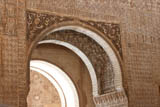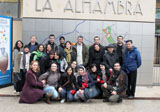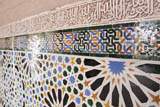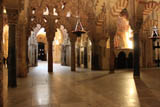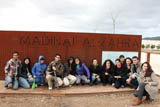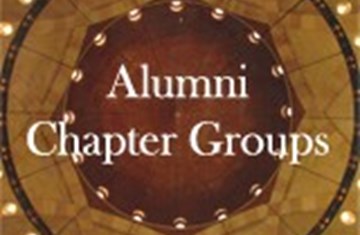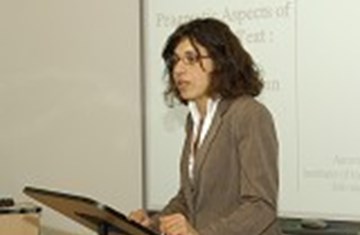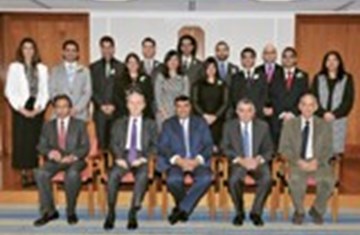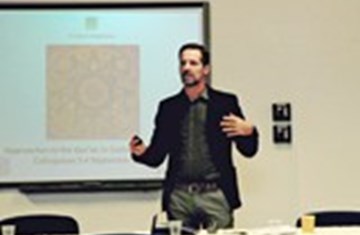IIS Graduate Students Visit Al-Andalus
Students from the Graduate Programme in Islamic Studies and Humanities (GPISH) and the Secondary Teacher Education Programme (STEP) embarked upon an educational trip to southern Spain on February 14, 2011. This annual trip provides students with first-hand exposure to the historical roots of Islam in Europe. The students were accompanied by Anna McSweeny, GPISH Lecturer, Dr Miriam Ali de Unzaga, Independent Researcher and GPISH alumna, Dr. Shantha Arulanantham, Dr Farouk Mitha, and Riaz Rehmtullah.
The group began their journey in Granada and took part in a walking tour of the historic district of Albaycin, located on a hill opposite the Alhambra. Since 1994, both areas have been designated world heritage sites. The Albaycin is a spectacular example of Moorish vernacular architecture, combined with traditional Andalusian construction techniques. The area is famous for the remains of medieval houses, mosques and public baths. The students visited many historical sites such as the Mirador San Nicolas, the Church of Santa Ana, the newly restored Caravanserai, as well as the Islamic Cultural Centre.
The visit to the vast palace complex of Alhambra, whose name derives from the Arabic al-Hamra, the ‘red fortress’, was a treat of architectural splendour. Mostly constructed by the Moorish rulers of the Nasrid Dynasty in the thirteenth and fourteenth centuries, it is one of Spain’s major tourist attractions and is seen as one of the most beautiful examples of Muslim architecture. The local tour guide ensured students had an opportunity to appreciate the magnificent decorative schema of arabesques, calligraphic inscriptions and geometric designs, including the later Christian additions, constructed by King Charles V in the sixteenth century, and the nearby gardens of the Generalife.
The combination of slender columns, fountains and water basins in the Alhambra, such as those in the Court of the Myrtles and Court of the Lions, is understood from inscriptions to be a physical representation of the descriptions of Paradise in Muslim poetry. The GPISH students attended an afternoon workshop within the Alhambra site to reflect on Islamic epigraphy and design, attempting to draw some of the artistic features, while STEP students held sessions to reflect on their experiences of the site.
The students’ next destination was Cordoba, where their first stop was the Great Cathedral-Mosque of Cordoba. The hypostyle mosque is seen as a pre-eminent example of medieval architecture and a primary religious and cultural relic of al-Andalus. It was begun in the late eighth century by the Umayyad ruler, ‘Abd al-Rahman I and went through four stages of construction and expansion. The mosque is also of great historical significance, visually depicting Cordoba’s religious, social, cultural and political changes. Today, it is also the site of Cordoba’s Cathedral. With its enclosed courtyard, rectangular prayer hall, and its system of columns supporting a double arcade of piers and arches, the Mosque follows a tradition established in the Umayyad and Abbasid mosques of Syria and Iraq. The students took part in a workshop on the ‘Ground Plans and Building Fabric of the Great Mosque’. This was a visual exercise testing their ability to work out where the Great Mosque had been extended.
Whilst in Cordoba, students also took a tour of the Old City, which included the Synagogue, Alcazar and the Jewish Quarter, as well as attended a cultural event at Tablao Flamenco Cardenal. The final stop just outside Cordoba was the Museum and Archaeological Site of Madinat al-Zahra, a palace-city built in the 10th century by Abd al-Rahman II. It was looted and destroyed in 1031 CE and the history of its recovery began in 1911 CE. It is said to be one of the largest archaeological sites in Europe of which only about 10% has been excavated to date. The nearby museum is a recent recipient of the Aga Khan Award for Architecture in 2010 and serves to facilitate an understanding and development of the archaeological site including developing projects and activities of a cultural and educational nature, as well as exhibits, research, restoration, conservation and preservation. The overall academic tour served its objective of helping students to appreciate the theoretical viewpoints that come through the academic programmes in which they are enrolled.

